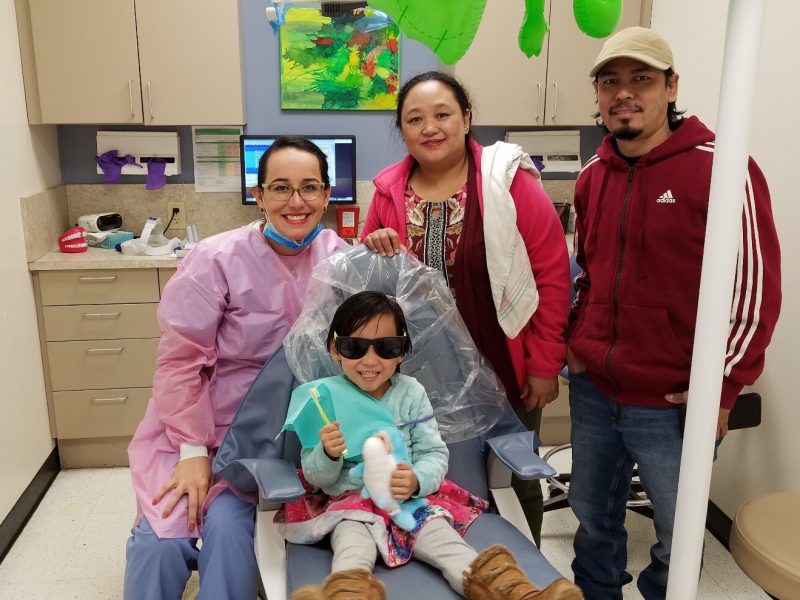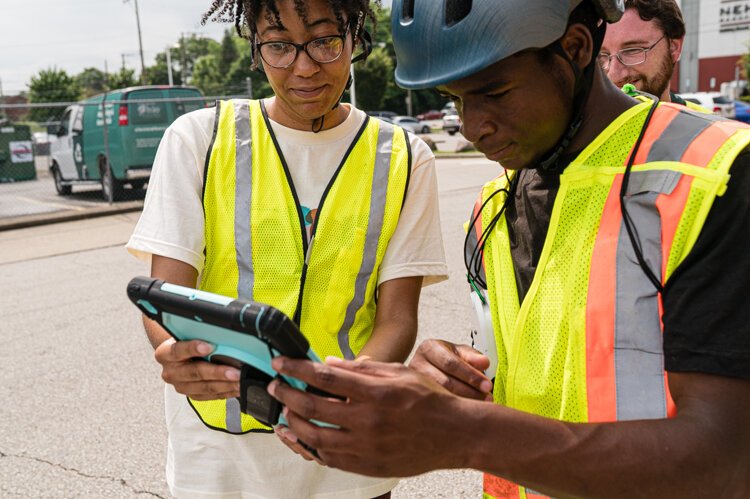Cincinnati’s Art Collective Consciousness
Cincinnati’s local art scene bristles with creative collectives. Brimming over with new ideas and unique ways to present them, talented artists are banding together, crossing disciplines, and facilitating discussions about not only how to make art but fund it as well. Soapbox writer Jane Durrell takes a look at a few of the Queen City’s collectives like Project Mill, CS 13, and the Marburg Project, who were recently selected by their peers to be funded to produce art at an innovative dinner.
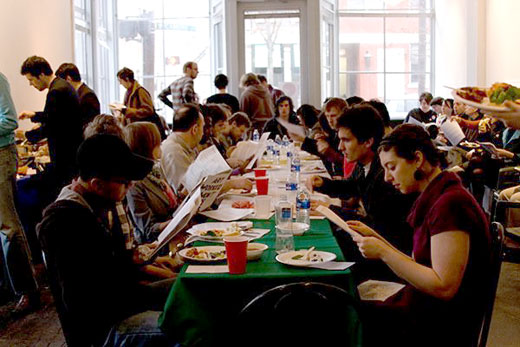 On a recent Sunday evening 70-plus people, surprisingly quiet, shared dinner at CS13 Gallery, 1219 Sycamore Street in Over-the-Rhine.
On a recent Sunday evening 70-plus people, surprisingly quiet, shared dinner at CS13 Gallery, 1219 Sycamore Street in Over-the-Rhine.
The diners were studying a long list of proposed art projects. Everyone who had paid $10 to attend the pot-luck dinner had a vote toward choosing the winner, who would receive the full proceeds ($730, it turned out) from the evening. The young artist community was there in force, along with people who have been part of the scene for years.
CS13 bills itself as “a modest effort to initiate and facilitate a broad creative dialogue, to encourage positive lifestyles, and to forge an engaged community” and is one of the lively signs of Cincinnati’s young artist colony. That colony includes graduates from local art and music schools, who just stay on. Others, attracted by Cincinnati’s relatively low cost of living and burgeoning art climate, come from elsewhere.
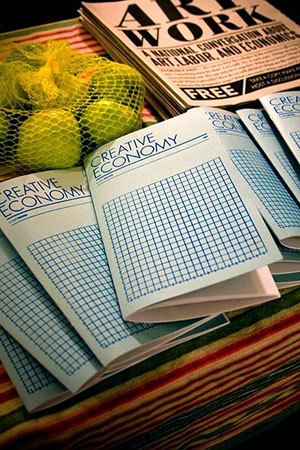 Until last December, another encouragement came from City Hall, with the city’s Arts Allocation program, now an unfortunate casualty of the economy. “Cincinnati was unique in offering grants to individual artists,” says Kristin Dietsche, founding director of the Women’s Theater Initiative and two-term member of the Arts Allocation Committee.
Until last December, another encouragement came from City Hall, with the city’s Arts Allocation program, now an unfortunate casualty of the economy. “Cincinnati was unique in offering grants to individual artists,” says Kristin Dietsche, founding director of the Women’s Theater Initiative and two-term member of the Arts Allocation Committee.
Cancellation of the program has left Cincinnati artists down but not out. Plenty of art is happening, some of it in classic artists’ collectives fashion. That is to say, the group is more important than individuals, and the work produced is a joint effort.
CS13’s “Creative Economy” exhibition, which dealt with artists’ means of survival in a shrinking economy, perfectly illustrates the open-ended work a collective may produce. It began with discussion of a tabloid publication issued by a Chicago collective and dealing with “Art, Labor, and Economics.” Then there was “Critical Run: Art Work,” in which discussion happened on a two-mile jog that looped around the gallery. A few days later the grant dinner took place; 29 project proposals had been submitted. The following Friday a lecture night drew 30 or so people to CS13, with talks relating to Cincinnati’s support of artists at various times and distribution of a newly published free zine, Creative Economy. None of this art can hang on the wall, but ideas as art have a 20th century history.
The Marburg Project’s proposal won the grant dinner money, with 18 votes (closest runner-up got nine votes), to offer “a meaningful resource for the city’s creative community, empowering those who would not traditionally have access to arts production, promotion, distribution . . .space for free-range, grass-fed artistic expression. . .creative services for low-cost, no-cost, trade-based community negotiations. . .”
Marburg takes its name from the one-time Hotel Marburg on Ludlow Avenue, Clifton, where Eddy Kwon, Caitlin Behle and other participants have living space.
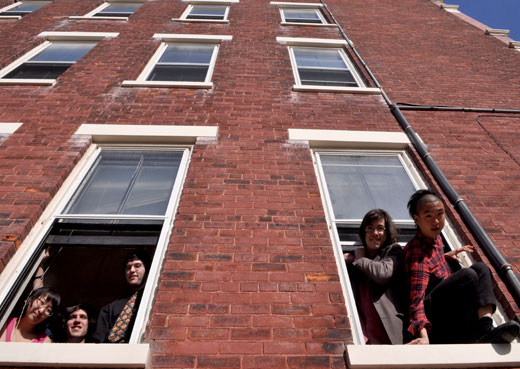 “We are trying to be very thoughtful in spending the grant money,” Kwon said. “We’re planning a large, awareness/fund raising event for the fall. . .hosted by the new ArtWorks gallery. . .a full concert of music, assortment of visual art . . .community literature. .[including] some of the projects we’ve undertaken. . .a compilation CD acknowledging ‘the incredible diversity of artistic energy the city has to offer. . .[to] share our city with the rest of the world.'”
“We are trying to be very thoughtful in spending the grant money,” Kwon said. “We’re planning a large, awareness/fund raising event for the fall. . .hosted by the new ArtWorks gallery. . .a full concert of music, assortment of visual art . . .community literature. .[including] some of the projects we’ve undertaken. . .a compilation CD acknowledging ‘the incredible diversity of artistic energy the city has to offer. . .[to] share our city with the rest of the world.'”
Kwon, who comes from Minneapolis and will finish up at U.C.’s College Conservatory of Music this spring, says young artists here “are becoming increasingly aware of the need for meaningful, grass-roots action. It is both very scary and extremely exciting.”
Like Marburg, CS13 has a core group but involves a changing number of people. Aaron Walker says CS13’s makeup “is not concretely defined. The core of ten to 12 meets weekly to determine upcoming programming and to cover financial expenses. The age range is 20-28.” Some are still in school, and most graduates do not have bachelor of fine arts degrees. There are degrees in social work, Middle Eastern studies, marketing, English, psychology, electronic media, and music performance among participants. Eclectic is a word that fits. The group, in operation since last June, focuses on art exhibitions, one-night performance events, small press publications and events “that don’t fit into any one of those categories,” says Walker.
 The Project Mill, “a network of creatives who make videos, art, t-shirts, posters, novels, music, websites, comics and coffee,” dispenses with location entirely. The web-based group is “made up of 15 varieties of creatives, some have day jobs, some practice their art professionally, some are bonafide starving artists of Cincinnati!” says Mandy Levy, a writer associated with Project Mill. Levy was one of the founders, in January, 2008, along with graphic designer Josh Mattie and videographer Pete Ohs. They were looking for outlets “to do cool things. . .were inspired by opportunities for creativity in Cincinnati, and super encouraged by the amount of artistic talent [here].”
The Project Mill, “a network of creatives who make videos, art, t-shirts, posters, novels, music, websites, comics and coffee,” dispenses with location entirely. The web-based group is “made up of 15 varieties of creatives, some have day jobs, some practice their art professionally, some are bonafide starving artists of Cincinnati!” says Mandy Levy, a writer associated with Project Mill. Levy was one of the founders, in January, 2008, along with graphic designer Josh Mattie and videographer Pete Ohs. They were looking for outlets “to do cool things. . .were inspired by opportunities for creativity in Cincinnati, and super encouraged by the amount of artistic talent [here].”
The group has since grown, its average age late 20s to early 30s, operating out of a virtual office with correspondence via the web but “our collaborations always come together in person.” The neat stuff testifies to their skills. Project Mill’s “American Rhapsody” won an Emmy. Asked what Cincinnati is like as home base, Levy says “Giving. Excited. Open to pretty much anything. Cheap.”
Artists’ collectives not only pool their work, they pool disciplines. The results are often mash-ups of music, digital elements, maybe dance, whatever talents are there to be used. Performance is a big part of Bunk, which presents visual art along with music shows and “strives to meld art, music and performance” says member Benjamin Brown. “Cincinnati is a great place for DIY art and music because of the abundance of cheap, interesting spaces and a music and arts scene big enough to be thriving but not so big that you can’t easily become a part of it,” he adds.
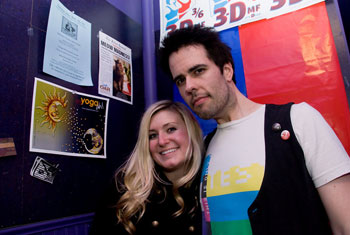 In addition to artists’ collectives, there are the artist-run galleries like U-Turn, which just opened a melodrama-deflating, multi-artist exhibition called “Breakups R Tough” that uses embroidery, photography, installation and other perspectives to draw a bead on “crisis points in the human experience.” One of the five founding artists, Patricia Murphy, lives above the gallery at 2159 Central Avenue, and all contribute to organizing shows that present “ambitious young emerging artists from all over,” says Matt Morris, another founder. Morris’s recent U-Turn show included pounds and pounds of flour sifted over the gallery floor, a means of altering gallery space “not viable for commercial galleries and not saleable,” he points out. But U-Turn can handle it. “Breakups” can be seen 12-4 p.m. Saturdays through April 24 or by appointment (u.turn.artspace@gmail.com).
In addition to artists’ collectives, there are the artist-run galleries like U-Turn, which just opened a melodrama-deflating, multi-artist exhibition called “Breakups R Tough” that uses embroidery, photography, installation and other perspectives to draw a bead on “crisis points in the human experience.” One of the five founding artists, Patricia Murphy, lives above the gallery at 2159 Central Avenue, and all contribute to organizing shows that present “ambitious young emerging artists from all over,” says Matt Morris, another founder. Morris’s recent U-Turn show included pounds and pounds of flour sifted over the gallery floor, a means of altering gallery space “not viable for commercial galleries and not saleable,” he points out. But U-Turn can handle it. “Breakups” can be seen 12-4 p.m. Saturdays through April 24 or by appointment (u.turn.artspace@gmail.com).
Next door to U-Turn, at Synthetica Gallery, 2157 Central Avenue, one of the oldest established artist collectives – TODT – notes April with The Cruelest Month, on view by appointment now through May 22 (513-602-2574). The Cincinnati-based group has been making and exhibiting installation art in national venues for over thirty years. Still another cooperative with history, Semantics Gallery, is nearby at 1107 Harrison Avenue, with an April group show from seven artists called “The Sour Princesses.” Like its neighbors, Semantics is open 12-4 Saturdays or by appointment (semantics.gallery@gmail.com)
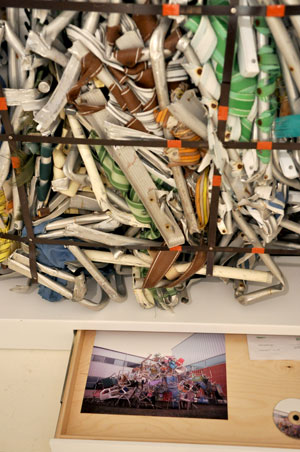 The long existence of entities like TODT and Semantics provides background and sometimes mentor-ship for today’s young artists. Matt Distel, director of Country Club Gallery and a close observer of the Cincinnati scene, says “I do think Cincinnati has a very, very good climate for artists that rarely seems to wane.” He mentions the Weston Gallery and ArtWorks as non-profits that foster local work, and would like to see the university galleries take a stronger role. Country Club itself, as a commercial gallery, is not a collective but does show some of the best of the area artists. It represents Simparch, a collective with Chicago and Cincinnati connections. Matt Lynch, sculpture instructor at DAAP, is the Cincinnati link.
The long existence of entities like TODT and Semantics provides background and sometimes mentor-ship for today’s young artists. Matt Distel, director of Country Club Gallery and a close observer of the Cincinnati scene, says “I do think Cincinnati has a very, very good climate for artists that rarely seems to wane.” He mentions the Weston Gallery and ArtWorks as non-profits that foster local work, and would like to see the university galleries take a stronger role. Country Club itself, as a commercial gallery, is not a collective but does show some of the best of the area artists. It represents Simparch, a collective with Chicago and Cincinnati connections. Matt Lynch, sculpture instructor at DAAP, is the Cincinnati link.
Distel adds “Except for a small handful of folks, artists who live and work in Cincinnati will need other means of support if they plan to only engage Cincinnati collectors. Unless you are lucky enough to find a true patron there simply are not enough people buying art in this town to sustain a decent annual salary. Teaching, art handling, design work, etc. are pretty common ways to supplement income.”
Cincinnati’s young artists are exploring ways to make the art they want to make, and to have it seen. What role should the city government play in supporting all this? Kristin Dietsche, drawing on her experience on the city’s now defunct arts allocation program, says “More important than city dollars for the arts is a city plan for supporting the arts. I do not think the city should fund artists or arts projects without a fair and open process. This can only come with stable annual funding that is not subject to political whim and the power dynamics of the annual budgeting process.”
A two-mile run looping around the CS13 gallery may seem to be a surprising way to tackle the problem, but on the other hand a lot of art is happening in Cincinnati.


